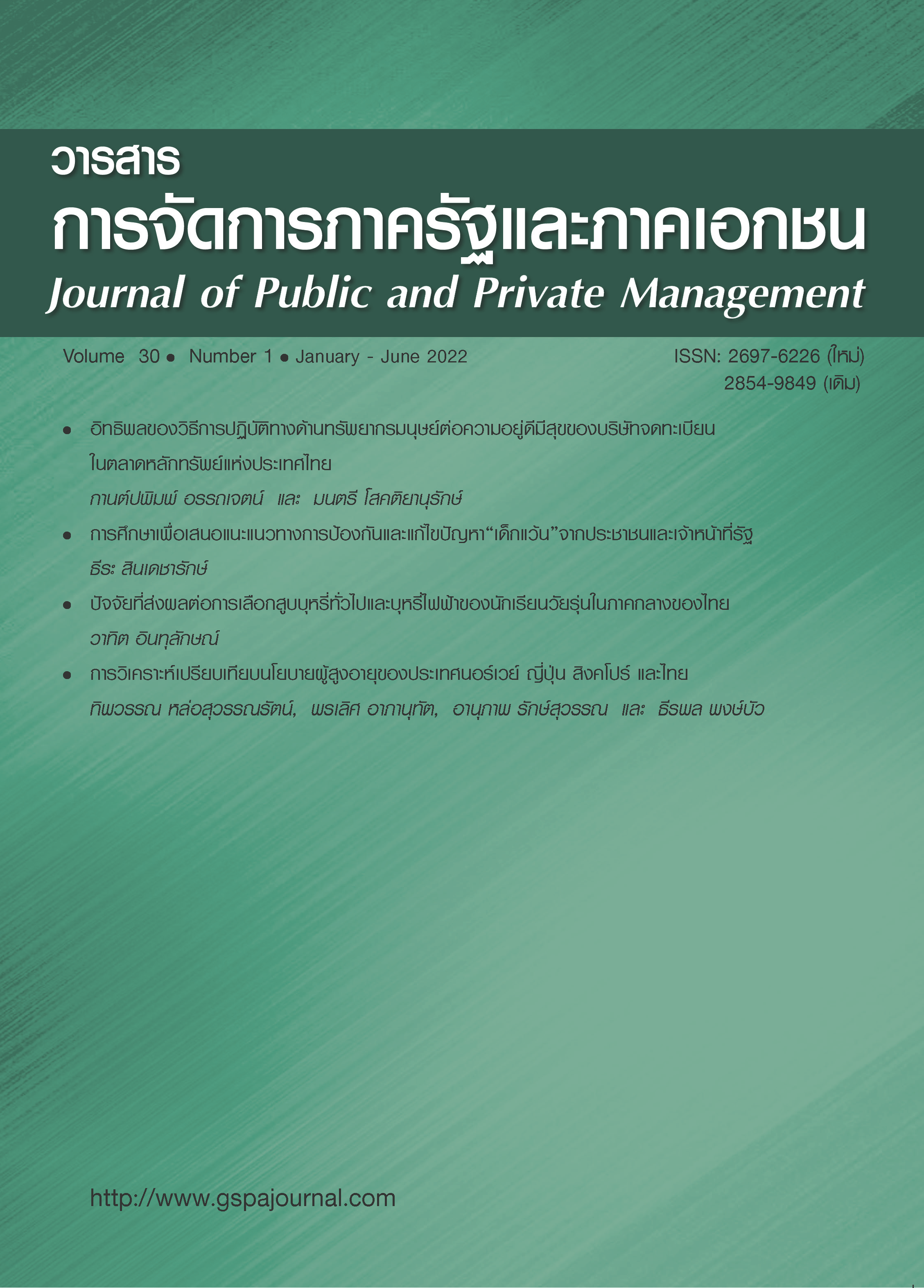The Factors affecting the Choice of Conventional and Electronic Cigarettes among Adolescent Students in the Central Region of Thailand
Keywords:
Smoking, conventional cigarettes, electronic cigarettes, adolescentsAbstract
This research studied the causal factors affecting the choice of conventional and e-cigarette smoking among adolescent students in the central region of Thailand. The structural relationship analysis technique (Structural Equation Model) was used to study the causal factors affecting the choice of conventional smoking and e-cigarettes among adolescents in the central region. By using survey research methodology, questionnaires were collected from secondary school students who had smoking habits, including e-cigarettes and conventional cigarettes of the central region, covering 7 educational districts with 400 cases. The study included Ratchathewi District, Huay Kwang District, Muang Nonthaburi District, Muang Pathum Thani District, Mueang Sing Buri District, Mueang Chachoengsao District and Muang Prachinburi District.
The results of this study found that overall factors had a significant positive influence on intentions of smoking. When considering the overview of the model, the causal factors after the research modification to determine the model fit, it was found that several values were acceptable. (Chi-square / df = 3.25, CFI = .966, NFI = .952, RMSEA = .075, SRMR = .047) which meet the criteria. Therefore, it can be said that the stakeholders in policy-making should consider this causal factors as the basic information for policy formulation in order to have a reduced intention effect for both types of smokers.
References
Case, K. R., et al. (2017). The relationships between sensation seeking and a spectrum of e-cigarette use behaviors: cross-sectional and longitudinal analyses specific to Texas adolescents. Addictive Behaviors, 73, 151-157.
Chidnayee, S., & Yottavee, W. (B.E.2561). Factors related with smoking behaviors of youth at Uttaradit. Boromarajonani College of Nursing, Uttaradit Journal, 10(1), 83-93.
Hfocus. (B.E.2562). Yaowachon Thai Royra 20 Sub Buri Fire Fa Siang Puai Rok Pod Akseb. Retrieved January 19, B.E.2563 from https://www.hfocus.org/content/2019/11/18004.
Jarungjitarry, S. et al. (B.E.2556). Padchai tee mee ittipon tor prued ti kam khan sub buri kong puying nai chumchon muaeng, Journal of Public Health, 43(3), 281-295.
Kunlayasiri, R. et al. (B.E.2562). Thailand Parental Supply and Use of Alcohol, Cigarettes & Drugs Longitudinal Study Cohort in Secondary School Students. Research Paper. Thai Health Promotion Foundation.
Leewirot, P., & Sriautit, K. (B.E.2559). Factors Affecting Smoking Behavior in Adolescent and The Effective Development Program of Cognitive Behavior Therapy for Reducing Smoking Behavior in out of School Adolescent. Research Paper. Thai Health Promotion Foundation.
Mahasuan, S. (B.E.2561). Factors Related to Smoking Initiation among Female Vocational Students in Chachoengsao Province. Thesis, Master of Nursing Science (Community Nurse Practitioner), Faculty of Nursing, Burapha University.
Matichom Online. (B.E.2563). Krob 2 Pee Kuen Pasri Buri Raidai Suppasamit Lod Khon Sub Mai Lod Utsahakum Yasub Rorae. Retrieved January 19, B.E.2563 from https://www.matichon.co.th/politics/politics-in-depth/news_1754046.
Nicksic, N. E., Snell, L. M., & Barnes, A. J. (2017). Does exposure and receptivity to e-cigarette advertisements relate to e-cigarette and conventional cigarette use behaviors among youth? Results from wave 1 of the population assessment of tobacco and health study. Journal of Applied Research on Children, 8(2), 1-18.
Pallant, J. (2013). SPSS Survival Manual. UK: McGraw-Hill Education.
Sakornpanich, C. (B.E.2554). Factors associated with non-smoking high school male students’ intention to smoke. J Prapokklao Hosp Clin Med Educat Center, 28(1), 44-52.
Sullivan, G. M., & Artino Jr, A. R. (2013). Analyzing and interpreting data from Likert-type scales. Journal of Graduate Medical Education, 5(4), 541-542.
Thai Health Promotion Foundation. (B.E.2558). Tidtang Paomai Lae Yudtasart Raya 10 Pee (B.E.2555-2564) Thai Health Promotion Foundation. Retrieved March 15, B.E.2563 from http://resource.thaihealth.or.th/library/academic/13320.
Thongthap, S. (B.E.2562). Na Tok Chai Wai Run Sub Buri Poem 3 San Khon Tor Pee. Retrieved January 17, B.E.2563 from https://www.thebangkokinsight.com/153796/.
Tobacco Control Research and Knowledge Management Center, Mahidol University. (B.E.2561). Raingan Satiti Khan Boripok Yasub Kong Pratet Thai B.E.2561. Bangkok: Tobacco Control Research and Knowledge Management Center, Mahidol University.
Ungsuchaval, T. (B.E.2555). Nayobai Rat Thai Kub Singchunrai Tee Chumpen (Necessary Evil): Kwam Khatyaeng Nai Botbatrat Kub Utsahakam Yasub. Retrieved January 19, B.E.2563 from http://public-law.net/publaw/view.aspx?id=1747.
Usaha, J., Gunvihok, T., Julasereekul, S., & Haruhanpong, V. (B.E.2558). Meta synthesis of preventive factors for cigarette smoking among Thai youths. Disease Control Journal, 41(4), 271-284.
Yeepoo, C., Kongthong, U., & Sriherun, B. (B.E.2561). The development of a learning activity model for reducing and stop smoking behavior of drug addiction for children and adolescent patients. Valaya Alongkorn Review (Humanities and Social Science), 8(1), 131-146.
Downloads
Published
How to Cite
Issue
Section
License

This work is licensed under a Creative Commons Attribution-NonCommercial-NoDerivatives 4.0 International License.



